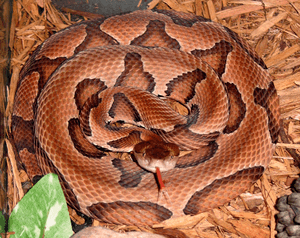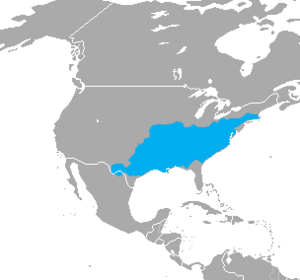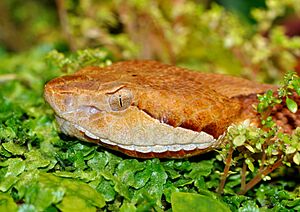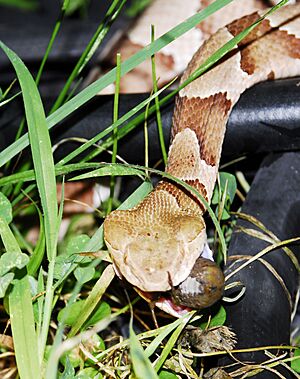Eastern copperhead facts for kids
The eastern copperhead (Agkistrodon contortrix), also known simply as the copperhead, is a type of venomous snake. It's a pit viper found only in eastern North America. This snake is part of the Viperidae family.
Eastern copperheads have special dark brown, hourglass-shaped patterns. These patterns are on a lighter reddish-brown or gray background. Their bodies are quite thick, not thin. Young copperheads are born with bright green or yellow tail tips. These tips turn darker brown or black within a year. Adult copperheads usually grow to be about 50 to 95 centimeters (20 to 37 inches) long, including their tail.
In most of North America, copperheads like to live in forests with trees that lose their leaves. They can also be found in rocky areas or wet, swampy places. In winter, they sleep in dens or cracks in rocks. They often share these spots with other snakes like timber rattlesnakes. Eastern copperheads eat many different kinds of animals, from insects to small mammals. Like most pit vipers, they usually wait quietly for their prey to come close.
Since they are common, people sometimes see them. Unlike other venomous snakes, copperheads often "freeze" (stay very still) instead of slithering away. They do this because their camouflage works so well. Bites usually happen when people accidentally step on or near them. Copperhead bites cause about half of all treated snake bites in the United States.
Scientists used to recognize five different types (subspecies) of copperheads. However, new genetic studies show that some of these are actually the same species, or even a different species entirely.
Quick facts for kids Eastern copperhead |
|
|---|---|
 |
|
| Conservation status | |
| Scientific classification | |
| Genus: |
Agkistrodon
|
| Species: |
contortrix
|
 |
|
Contents
What's in a Name?
The name Agkistrodon comes from two Greek words. Ankistron means "hook" or "fishhook," and odon means "tooth."
The second part of its name, contortrix, comes from the Latin word contortus. This means "twisted" or "complex." It likely refers to the snake's unique pattern. The dark bands on its back are wide on the sides but get narrow and "pinched" in the middle, looking a bit twisted.
How to Spot a Copperhead
Adult copperheads usually measure between 50 and 95 centimeters (20 to 37 inches) long. Some can grow over 1 meter (3 feet) long, but this is rare. Males are often a bit larger than females.
Their body is quite sturdy, and their head is wide and clearly separate from their neck. The snout (nose area) slopes downwards. This makes their head look less blunt than a similar snake, the cottonmouth.
Copperheads have 21 to 25 rows of scales around the middle of their body. They also have special scales on their belly and under their tail.
Their color pattern is a pale tan to pinkish-tan background. This background color gets darker towards the sides of the body. Over this, they have 10 to 18 dark crossbands. These bands are light tan to pinkish-tan in the center but darker at the edges. They are narrow on the back but widen on the sides of the body. Sometimes, these bands are split in the middle, making them look like alternating half-bands. Dark brown spots are also found on their sides, near their belly.
The belly is usually the same color as the background, but it can be a bit whitish. Young copperheads have a very clear pattern on their tail, with 7 to 9 crossbands. The tip of their tail is bright yellow.
Where They Live and What They Like
The eastern copperhead lives in many parts of North America. In the United States, they are found from Texas and Oklahoma in the west, all the way to the Atlantic coast. Their range goes north to states like Iowa, Illinois, New York, and Massachusetts. They are not found in southern Georgia or the Florida Peninsula. They also live in parts of northern Mexico.
Copperheads live in different places depending on the region. In most of North America, they prefer forests with trees that lose their leaves. They are often found near rocky areas and ledges. However, they also live in low, wet, and swampy places.
During winter, they hibernate (sleep) in dens or cracks in limestone rocks. They sometimes share these dens with other snakes, like timber rattlesnakes and black rat snakes. In states near the Gulf of Mexico, they can also be found in pine forests. In the deserts of West Texas and northern Mexico, they live near rivers or streams, and sometimes in dry streambeds.
Conservation Status
The eastern copperhead is listed as a species of "least concern" by the IUCN. This means they are not currently at risk of disappearing in the near future. Their population was stable when last checked in 2007.
How They Behave
In the southern United States, copperheads are active at night during the hot summer. But in spring and fall, they are often active during the day.
Unlike some other venomous snakes, copperheads often "freeze" (stay very still) instead of slithering away when approached. This is why many bites happen when people accidentally step on or near them. This "freezing" behavior likely developed because their camouflage works so well. When they are on dead leaves or reddish soil, they can be almost impossible to see. They often stay still even when someone gets very close. They usually only strike if they are touched.
Like most other pit vipers, copperheads will shake their tails when they feel threatened. They can vibrate their tails more than 40 times per second!
What They Eat and How They Hunt
The eastern copperhead eats a wide variety of prey. This includes invertebrates (like insects and spiders) and vertebrates (like small animals with backbones). Young copperheads tend to eat more insects and cold-blooded animals. Adult copperheads eat more warm-blooded animals. However, both young and old copperheads will eat whatever food they can find. Their diet can also change depending on where they live.
Studies in different states show that copperheads often eat cicadas, caterpillars, lizards, voles, and mice. There are stories of copperheads found high up in bushes and trees. They were looking for newly emerged cicadas, sometimes as high as 40 feet off the ground!
Other foods they eat include millipedes, spiders, beetles, dragonflies, grasshoppers, and praying mantises. They also eat salamanders, frogs, other snakes, small turtles, small birds, young opossums, squirrels, chipmunks, rabbits, bats, shrews, moles, and rats.
Like most pit vipers, the eastern copperhead usually hunts by waiting quietly. It finds a good spot and waits for a suitable animal to come by. However, when hunting insects like caterpillars or cicadas, copperheads will actively chase their prey.
Young copperheads use their bright yellow tail tip to attract frogs and lizards. This behavior is called caudal luring. They use their sight, smell, and heat-sensing pits to find prey. After they bite an animal, they use smell and taste to track it down. Smaller prey and birds are often held in the mouth until they die. Larger prey are usually bitten, released, and then tracked until they die. Copperheads sometimes eat dead animals too. Pregnant females usually don't eat much. A copperhead can eat up to twice its own body weight in a year.
How They Have Babies
Eastern copperheads usually breed in late summer. However, they don't have babies every year. Sometimes, a female will have young for several years in a row, then take a break from breeding.
They give birth to live young, meaning no eggs are laid. Each baby snake is about 20 centimeters (8 inches) long when born. A typical litter has four to seven babies. But sometimes, there can be as few as one or as many as 20. The young look like smaller versions of the adults. They are lighter in color and have that yellowish-green tail tip. This tail tip is used to attract lizards and frogs for them to eat.
Special Way of Having Babies
Sometimes, female copperheads can have babies without a male. This is called parthenogenesis. It's a natural way of reproduction where embryos grow without fertilization. This means they can switch from having babies with a partner to having them alone. This has been seen in both copperheads born in captivity and those found in the wild.
Copperhead Venom
Even though eastern copperheads are venomous, they are generally not aggressive. Bites are rarely deadly. Copperhead venom is not as strong as the venom of many other pit vipers. It's also a bit weaker than the venom of its close relative, the cottonmouth.
Copperheads often give a "warning bite" if they are stepped on or bothered. In these bites, they inject only a small amount of venom, or sometimes no venom at all. Bites with no venom are called "dry bites" and are common with copperheads. Even a dead pit viper can still deliver venom, so they should always be treated with caution.
If bitten, symptoms can include extreme pain, tingling, throbbing, swelling, and severe nausea. The venom can damage muscle and bone tissue, especially if the bite is on a hand or foot. Any bite from a venomous snake should be taken very seriously. You should get medical help right away, as allergic reactions or infections are possible.
Scientists have found a protein in copperhead venom called "contortrostatin." In studies on mice, this protein has stopped the growth of cancer cells. It also stopped tumors from spreading to other parts of the body. However, this research is still in early stages and more testing is needed for humans.
There is an antivenom called CroFab that can treat copperhead bites. It is used when a person shows clear reactions to the venom, like swelling. If there's no reaction, antivenom might not be needed. This is because antivenom can sometimes cause an allergic reaction itself. Other treatments include pain medicine, tetanus shots, and medical care to watch for problems. Many copperhead bite victims survive without needing antivenom. One study of 88 copperhead bite victims found that all of them survived and none needed antivenom.
Subspecies (Types of Copperheads)
Scientists used to think there were five different types (subspecies) of copperheads. But new genetic studies have changed this understanding. Now, it's believed that some of these types are actually the same species, or even a completely different species.
| Previous Name | Current Name | Where They Live |
|---|---|---|
| Southern copperhead
Agkistrodon contortrix contortrix (Linnaeus, 1766) |
Eastern copperhead
Agkistrodon contortrix (Linnaeus, 1766) |
The United States: from eastern Texas, Oklahoma, Kansas, and Nebraska, eastward to the Atlantic coast. North to Iowa, Illinois, Indiana, Ohio, Pennsylvania, New York, Massachusetts, and parts of Connecticut. Not found in southern Georgia and Florida. |
| Broad-banded copperhead
Agkistrodon contortrix laticinctus Gloyd & Conant, 1934 |
Broad-banded copperhead
Agkistrodon laticinctus Gloyd & Conant, 1934 |
In the United States from eastern Kansas, southwest through central Oklahoma, central and western Texas. Also in nearby areas of northern Chihuahua and Coahuila, Mexico. |
| Northern copperhead
Agkistrodon contortrix mokasen Palisot de Beauvois, 1799 |
Eastern copperhead
Agkistrodon contortrix |
The United States, in southern Illinois, northeastern Mississippi, northern Alabama, northern Georgia, northeast to Massachusetts. Also in the Appalachian Mountain region. |
| Osage copperhead
Agkistrodon contortrix phaeogaster Gloyd, 1969 |
Eastern copperhead
Agkistrodon contortrix |
The United States, in eastern Kansas, southeastern Nebraska, and a large part of Missouri. |
| Trans-Pecos copperhead
Agkistrodon contortrix pictigaster Gloyd & Conant, 1943 |
Broad-banded copperhead
Agkistrodon laticinctus |
The western Texas region and nearby areas of northern Chihuahua and Coahuila, Mexico. |
Images for kids
See also
 In Spanish: Agkistrodon contortrix para niños
In Spanish: Agkistrodon contortrix para niños











